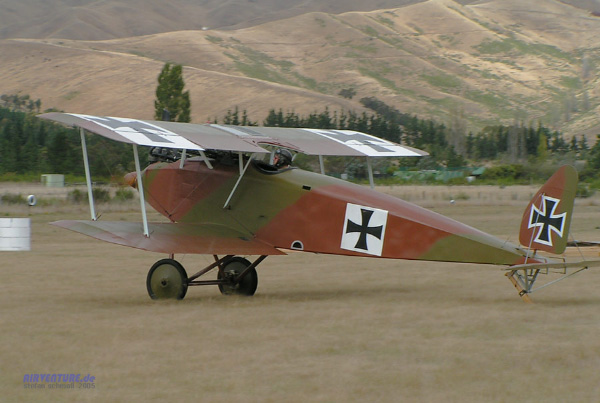
|
 |
Halberstadt D.II |
 |
 |
 |
 |
 |
|---|---|---|---|---|---|---|---|
 |
 |
 |
 |
 |
|||
| The D.1 was designed in 1915 was powered by a 100 hp Mercedes D.I engine. The upgraded D.II entered service in 1916, and was powered by the larger 120 hp D.II Mercedes engine.2 The wings were of a two-bay staggered configuration, fabric covered, with wooden spar and ribs. The top wing had an angular cut-out in the center-section trailing edge and the engine radiator was located on the top wing, offset to starboard. Ailerons were of equal chord and located on the top wing only. The fuselage was a wire braced, wooden box girder construction that tapered to a horizontal knife edge and was fabric covered except for plywood decking in front of the cockpit. Steel tubing was used for the wire-braced struts, rudder support and a plain vee undercarriage.3 |
|
When the D.II first entered service in 1916, it was assigned to reconnaissance units for escort work and to the Kampfeinsitzerkommandos, but from early Autmn it joined with the far superior Albatross Scouts in the early
Jagdstaffeln.4
In late 1916, the Halberstadt D type aircraft were becoming obsolete and were being superseded in the Jagdstaffeln by the superior Albatros fighters by the autumn of 1916, but after a crack developed in his Albatros, Manfred Von Richthofen returned for a time back to the Halberstadt D.II.5 According to one source, only eighty-five Halberstadt D types were produced.6 |
| Specifications: | |
|---|---|
| Halberstadt D.II | |
| Dimensions: | |
| Wing span: | 28 ft 11 in (8.80 m) |
| Length: | 23 ft 11 in (7.30 m) |
| Height: | 8 ft 9 in (2.67 m) |
| Weights: | |
| Empty: | 1,144 lb (519 kg) |
| Loaded Weight: | 1,606 lb (728 kg) |
| Performance: | |
| Maximum Speed: | 90 mph (145 km/h) |
| Rate of Climb: | 656 ft/min (200 m/min) climb to 9,850 ft. (3,000 m) |
| Powerplant: | |
| One Mercedes D.II six cylinder in-line, 90 kW (120 hp). | |
| Armament: | |
|
One synchonized, starboard mounted, forward-firing 7.92 mm (.312 in) Spandau LMG 08 machine gun, firing through the propeller arc. | |
Endnotes:
|
1. E.F. Cheesman ed. Fighter Aircraft of the 1914-1918 war. Fallbrook, California: Aero Publishers Inc., 1964. 134. 2. Ibid. 3. Peter Gray and Owen Thetford. German Aircraft of the First World War. Garden City, New York: Doubleday & Company, Inc. 146. 4. Kenneth Munson. The Pocket Encyclopedia of World Aircraft in Color. Fighters 1914-19. Attack and Training Aircraft. New York: The MacMillan Company, 1969. 113. 5. E.F. Cheesman ed. 134. 6. Ibid. |
Return to Aircraft Index
©Larry Dwyer. The Aviation History On-Line Museum.
All rights reserved.
Created November 13, 2009. Updated November 7, 2013.
